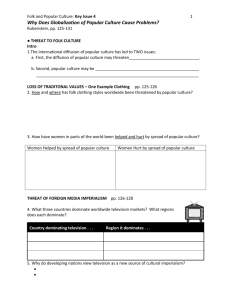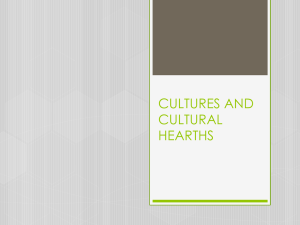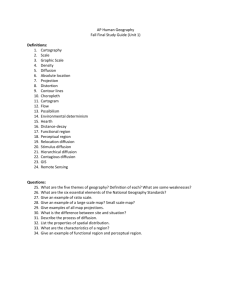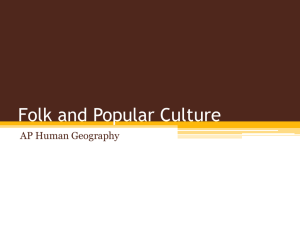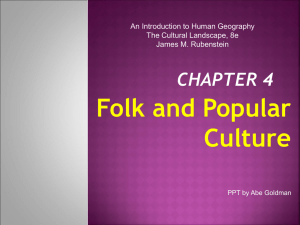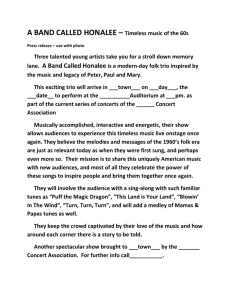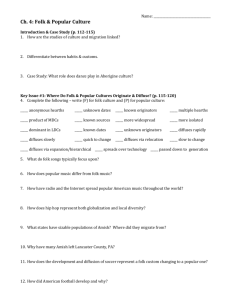ch 7 study guide - Bloomer School District
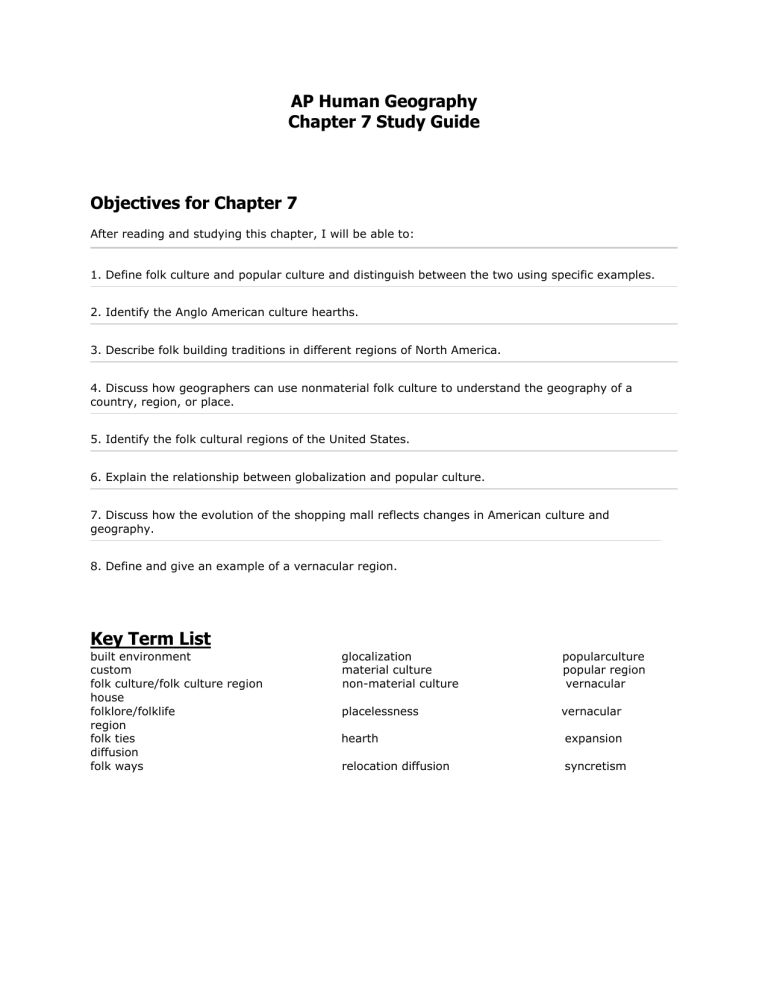
AP Human Geography
Chapter 7 Study Guide
Objectives for Chapter 7
After reading and studying this chapter, I will be able to:
1. Define folk culture and popular culture and distinguish between the two using specific examples.
2. Identify the Anglo American culture hearths.
3. Describe folk building traditions in different regions of North America.
4. Discuss how geographers can use nonmaterial folk culture to understand the geography of a country, region, or place.
5. Identify the folk cultural regions of the United States.
6. Explain the relationship between globalization and popular culture.
7. Discuss how the evolution of the shopping mall reflects changes in American culture and geography.
8. Define and give an example of a vernacular region.
Key Term List
built environment glocalization popularculture custom material culture popular region folk culture/folk culture region non-material culture vernacular house folklore/folklife placelessness vernacular region folk ties hearth expansion diffusion folk ways relocation diffusion syncretism
Discussion Questions
1.
What is folk culture?
2.
What folk cultural hearths and building traditions are found in anglo-America?
3.
What elements and patterns of non-material folk culture can we observe in Anglo-America?
4.
What folk culture regions are recognized for the eastern United States?
5.
What is popular culture, and what are its universal and Anglo-American evidences?
6.
Are there regional differences and emphases in our mass popular culture?
_______________________________________________________________________
7.
Folk culture vs. pop culture a.
What contrasts can we draw between folk culture and pop culture? b.
What different sorts of material and non-material elements identify them? c.
How are folk culture and pop culture interconnected and interrelated?
8.
How many of the early settlement cultural hearths of North America can you name? Did early immigrants create uniform built environments within them? If not, why not?
9.
When and under what circumstances did popular culture begin to erode the folk and ethnic cultural differences between Americans?
10.
Personal cultural profile: a.
What traces of folk culture do you carry? b.
To what degree does popular culture affect your decisions on dress? On entertainment?
On recreation?
11.
How are we able to recognize hearths and trace diffusions of folk cultural elements? Do items of popular culture have hearths and diffusion paths that are equally traceable? Why or why not?
12.
What kinds of connections can you discern between the nature of the physical environment and the characteristics of different vernacular house styles in North America? In other parts of the world?
13.
If, as some have observed, there is a close relationship between the natural environment and the artifacts of folk culture, is there likely to be similar causal connection between the environment and expressions of popular culture? Why or why not?
Critical Thinking Questions
1. Why should society preserve folk culture traditions?
2. Can you think of examples of folk culture traditions that have become popular culture?
3. Besides folk fencing and house building, what other folk traditions might be useful to distinguish among regions of the United States?
4. What folk medicine traditions are practiced in your family?
5. Sports are a big part of popular culture around the world. Can sports be used as a window to other aspects of a society's culture? How?
Online Quiz
http://glencoe.mcgraw-hill.com/sites/0002222010/student_view0/chapter7/quiz.html
http://glencoe.mcgraw-hill.com/sites/0002222010/student_view0/chapter7/multiple_choice_quiz.html
http://quizlet.com/9361042/chapter-7-human-geography-folk-and-popular-culture-flash-cards/
Case Studies
“Strange Roofs and Odd Gables”
by Jon C. Malinowski, Ph.D.
https://highered.mcgraw-hill.com/sites/dl/free/0073522856/111604/housetypes.pdf
“Geography of Rock n’ Roll”
by Jon C. Malinowski, Ph.D.
https://highered.mcgraw-hill.com/sites/dl/free/0073522856/111604/rockandroll.pdf
Web Links
Overview http://culturalgeog2.blogspot.com/2008/03/folk-and-popular-culture.html
Folk Culture http://www.mhhe.com/links/1254/1240/1512/1517/1522/index.html
American Folklore http://americanfolklore.net/folklore/united-states-folklore/wisconsin-folklore/
Popular Culture http://www.mhhe.com/links/1254/1240/1512/1517/1523/index.html
CHAPTER 7: FOLK AND POPULAR CULTURE: DIVERSITY AND UNIFORMITY
OVERVIEW
1. Culturally complex societies display social and spatial diversity rooted in ethnic distinctiveness (reviewed in Chapter 6) and in folk cultural differences. They are simultaneously being unified by popular cultural elements spread by modern technologies of communication and transportation. Anglo America serves as a case study of the temporally and spatially varying impact of these separate cultural influences.
2. In Anglo America, material and nonmaterial folk culture developed from local adaptations and modifications of imported artifacts, mentifacts, and sociofacts. Although fast disappearing, evidence of folk culture regions may still be discerned in the built landscape and in local customs. They had their origins in relocation diffusion to recognizable East Coast hearth districts from which expansion diffusion carried cultural identities to the continental interior. Each
“hearth” had its own mix of immigrants and its own distinctions of landscape and customs.
3. Vernacular housing styles —reflecting spatially varied ideas and materials—are an indicator of folk cultural diversity. Those styles were part of col onists’ imported material culture modified by local resource availability and environmental requirements. Each of the hearth regions displayed and diffused its own folk housing designs: French-inspired in the Lower St. Lawrence
Valley and English in the Upper Valley and southern New England, for example. The impress of
English and continental European ethnics —in different mix from different origins—was displayed in the Delaware Valley and Chesapeake Bay hearths of the Middle Atlantic. The
Southern Tidewater showed English, French, African, and West Indian influences, while French,
Spanish, and Haitian inputs were evident in the Delta hearth. Hispanics in the Southwest and
Mormons in the deep interior were other charter groups introducing distinctive indigenous or diffused vernacular housing styles.
4. From the eastern U.S. hearths, regionally generalized as the New England, Middle Atlantic, and Lower Chesapeake, traceable diffusion paths carried evidence of folk cultural movement away from the coast; an interior “national hearth” of intermingled streams developed in the
Upper Ohio Valley.
5. Nonmaterial folk culture is gradually lost in modernizing societies, though reminders of it persist in foods, folklore, and song. Regional folk and ethnic cuisines are preserved in cookbooks and local and regional fairs and “fests.” Food and drink specialties reflect both immigrant traditions and indigenous foodstuffs and recipe adoptions. Song regions also reflect imported tradition and American regional isolation, experiences, and traits. Folk medicines and
cures derive from imported traditional plant remedies and a vast new supply of native medicines revealed by Amerindians.
6. Composite folk cultural regions of the eastern United States suggest several hearths of origin and diffusion: southern and eastern New England, southeastern Pennsylvania,
Chesapeake Bay, the coastal Southeast, French Canada, and the Hispanic borderlands.
7. Such regions are blurred by increasingly pervasive popular culture, submerging regional differences in the uniformity imposed by nationally standardized facilities and tastes. Even in the face of leveling national sameness, a greater wealth and variety of goods and ideas free people from the rigid constraints of folk cultural isolation and local uniformities.
8. Even with national uniformities, different sections of the Anglo American culture realm are felt by their inhabitants to be, somehow, separate and unique. Vernacular regions are an enduring spatial recognition of the threads of diversity within, specifically, United States society.
A prominent part of Western culture is the behavior of shopping and its main institution, the shopping mall. Geodemographic marketing is used to market to the uniquess of the shopping cultures in each of the cultural and vernacular regions.
EXPANDED KEY WORDS LIST annual round artifacts balloon frame
Black folk song built environment cante hondo central hall house
Charleston single house country music crib cuisine custom dogtrot
Dutch house expansion diffusion folk folk culture folk culture region folk housing folklife folklore folk ties folkways
four-over-four house gansta rap garrison house rap reality rap geodemographic marketing reggae relocation diffusion ger central-hall house rock steady hearth saddlebag house hip hop saltbox house hip hop culture sha
I-house shotgun house lazy-T house sociofacts life style centers
Spanish adobe house syncretism manyatta dogtrot house material culture urban blues mentifacts vernacular region moonshine yurt neolocalism
New England large house gable-front house nonmaterial culture Norman cottage
Norman cottage garrison house pen
Georgian house placelessness grenier house popular culture popular region lazy-T house
Quebec cottage
Montreal house
Quebec cottage
